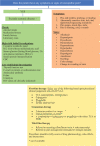Expert review and recommendations for the management of acute, chronic, and neuropathic pain in Qatar
- PMID: 34285886
- PMCID: PMC8273477
- DOI: 10.5339/qmj.2021.19
Expert review and recommendations for the management of acute, chronic, and neuropathic pain in Qatar
Abstract
Background: Pain management is an evolving area of expertise in Qatar. Gaps in knowledge, inadequate training for physicians and nurses, and the absence of policies/guidelines are the main barriers to effective pain management in Qatar. In addition, the use of certain pain medication, especially opioids, is highly regulated, limiting their availability in outpatient pain management. These factors are responsible for the undertreatment of pain in Qatar. This study aimed to standardize evidence-based local recommendations for pharmacological treatment of pain in Qatar.
Methods: An expert panel of physicians from different disciplines, with experience in diagnosis and treatment of the three pain types (i.e., acute, chronic, and neuropathic), was convened for two face-to-face meetings in Doha, Qatar, on November 29, 2019, and on February 22, 2020, with subsequent virtual meetings. A literature search was performed on Medline and Google Scholar databases from inception till December 2019, and all relevant articles were selected. Based on these articles and repeated feedback from the authors, the final pain treatment protocols were developed.
Results: Recommendations for the treatment of acute pain, based on pain severity, followed three approaches: acetaminophen/paracetamol or non-steroidal anti-inflammatory drugs (NSAIDs) for mild pain and moderate pain and referral to a pain specialist for severe pain. Acetaminophen/paracetamol or NSAIDs is recommended for chronic pain, and the use of opioids was strongly discouraged because of its long-term side effects. For neuropathic pain, tricyclic antidepressants or gabapentin or pregabalin or serotonin-norepinephrine reuptake inhibitors were recommended first-line agents. Non-responders must be referred to neurologists or a pain specialist.
Conclusion: The expert panel provides recommendations for the management of acute, chronic, and neuropathic pain based on international guidelines adapted to local practice and treatment availability in Qatar. More importantly, the panel has recommended taking extreme caution in the use of opioids for long-term management of chronic pain and to refer the patient to a pain specialist clinician as required.
Keywords: acute pain; analgesics; chronic pain; neuropathic pain; pain management.
© 2021 Elmoheen, Nazal, Zubaidi, Siddiqui, Alhatou, licensee HBKU Press. This is an open access article distributed under the terms of the Creative Commons Attribution license CC BY 4.0, which permits unrestricted use, distribution and reproduction in any medium, provided the original work is properly cited.
Figures




Similar articles
-
Opioids and the management of chronic severe pain in the elderly: consensus statement of an International Expert Panel with focus on the six clinically most often used World Health Organization Step III opioids (buprenorphine, fentanyl, hydromorphone, methadone, morphine, oxycodone).Pain Pract. 2008 Jul-Aug;8(4):287-313. doi: 10.1111/j.1533-2500.2008.00204.x. Epub 2008 May 23. Pain Pract. 2008. PMID: 18503626
-
A Systematic Review and Meta-analysis Comparing the Efficacy of Nonsteroidal Anti-inflammatory Drugs, Opioids, and Paracetamol in the Treatment of Acute Renal Colic.Eur Urol. 2018 Apr;73(4):583-595. doi: 10.1016/j.eururo.2017.11.001. Epub 2017 Nov 22. Eur Urol. 2018. PMID: 29174580
-
Update on guidelines for the treatment of chronic musculoskeletal pain.Clin Rheumatol. 2006;25 Suppl 1:S22-9. doi: 10.1007/s10067-006-0203-8. Epub 2006 Jun 2. Clin Rheumatol. 2006. PMID: 16741783 Review.
-
Neuropharmacology of Neuropathic Pain: A Systematic Review.Cureus. 2024 Sep 9;16(9):e69028. doi: 10.7759/cureus.69028. eCollection 2024 Sep. Cureus. 2024. PMID: 39385859 Free PMC article. Review.
-
Combination treatment of neuropathic pain: Danish expert recommendations based on a Delphi process.J Pain Res. 2017 Jun 26;10:1467-1475. doi: 10.2147/JPR.S138099. eCollection 2017. J Pain Res. 2017. PMID: 28721089 Free PMC article.
References
-
- Orr PM, Shank BC, Black AC. The role of pain classification systems in pain management. Crit Care Nurs Clin North Am. 2017;29(4):407–18. - PubMed
LinkOut - more resources
Full Text Sources
